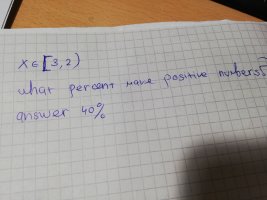You are using an out of date browser. It may not display this or other websites correctly.
You should upgrade or use an alternative browser.
You should upgrade or use an alternative browser.
What percent make positive numbers?
- Thread starter Loki123
- Start date
Correction, it's supposed to say - 3There are infinite numbers in this interval, how do I present them as percents? Also this interval does not include 2, which makes it confusing.
View attachment 32221
BigBeachBanana
Senior Member
- Joined
- Nov 19, 2021
- Messages
- 2,181
How much do you know about continuous probability density and cumulative distribution functions.Correction, it's supposed to say - 3
[math]\Pr(X \le a)= \int_{\-\infty}^{a} f(x) dx[/math]
PS: I didn’t get a chance to look at your other question.
Nothing right now. But I have probability classes this week so maybe I'll know something. Although from what I know thr questions are mostly likeHow much do you know about continuous probability density and cumulative distribution functions.
[math]\Pr(X \le a) \int_{\-\infty}^{a} f(x) dx [/math]PS: I didn’t get a chance to look at your other question.
You have 5 balls, 3 are white, 2 are yellow, one is black, how many do you have to take (not looking) to surely have a black ball.
BigBeachBanana
Senior Member
- Joined
- Nov 19, 2021
- Messages
- 2,181
You’re talking about discreet probability. Whereas this question talks about an interval, which deal with continuous probability,require integration.Nothing right now. But I have probability classes this week so maybe I'll know something. Although from what I know thr questions are mostly like
You have 5 balls, 3 are white, 2 are yellow, one is black, how many do you have to take (not looking) to surely have a black ball.
pka
Elite Member
- Joined
- Jan 29, 2005
- Messages
- 11,971
Three white balls, two yellow & one black make six balls not five.Nothing right now. But I have probability classes this week so maybe I'll know something. Although from what I know thr questions are mostly like
You have 5 balls, 3 are white, 2 are yellow, one is black, how many do you have to take (not looking) to surely have a black ball.
BigBeachBanana
Senior Member
- Joined
- Nov 19, 2021
- Messages
- 2,181
@Loki123, since you haven't learned anything related to this topic. I don't mind providing a solution.
The answer seems to assume that the probability density is uniform, meaning you have equally likely chance to pick a number within the interval.
Let [imath]X[/imath] be a random variable represents the number that get pick out of the interval. So the probability of picking any number with in the interval is: [imath]p(x)=\frac{1}{b-a}=\frac{1}{2-(-3)}=\frac{1}{5}[/imath].
Now, to find the probability of picking a positive number, this means we're picking [imath]x[/imath] from the interval [imath](0,2)[/imath].
Lastly, sum up all the probability of picking all the numbers within [imath](0,2)[/imath].
[math]\Pr( 0 < X <2 ) =\int_{0}^{2}\frac{1}{5}\, dx=0.4[/math]
The answer seems to assume that the probability density is uniform, meaning you have equally likely chance to pick a number within the interval.
Let [imath]X[/imath] be a random variable represents the number that get pick out of the interval. So the probability of picking any number with in the interval is: [imath]p(x)=\frac{1}{b-a}=\frac{1}{2-(-3)}=\frac{1}{5}[/imath].
Now, to find the probability of picking a positive number, this means we're picking [imath]x[/imath] from the interval [imath](0,2)[/imath].
Lastly, sum up all the probability of picking all the numbers within [imath](0,2)[/imath].
[math]\Pr( 0 < X <2 ) =\int_{0}^{2}\frac{1}{5}\, dx=0.4[/math]
Last edited:
You’re talking about discreet probability.
discrete probability
"Discreet" involves being careful about one's speech or actions.
Where did this come from(x)=b−a1
Does it not make a difference that 2 isn't included unlike the other numbers?@Loki123, since you haven't learned anything related to this topic. I don't mind providing a solution.
The answer seems to assume that the probability density is uniform, meaning you have equally likely chance to pick a number within the interval.
Let [imath]X[/imath] be a random variable represents the number that get pick out of the interval. So the probability of picking any number with in the interval is: [imath]p(x)=\frac{1}{b-a}=\frac{1}{2-(-3)}=\frac{1}{5}[/imath].
Now, to find the probability of picking a positive number, this means we're picking [imath]x[/imath] from the interval [imath](0,2)[/imath].
Lastly, sum up all the probability of picking all the numbers within [imath](0,2)[/imath].
[math]\Pr( 0 < X <2 ) =\int_{0}^{2}\frac{1}{5}\, dx=0.4[/math]
BigBeachBanana
Senior Member
- Joined
- Nov 19, 2021
- Messages
- 2,181
It comes from the continuous uniform distribution. You can learn more about it here.Where did this come from
For continuous probability, the inclusion does not impact the result because, in general:Does it not make a difference that 2 isn't included unlike the other numbers?
[math]\Pr(X \le x)=\Pr ( X < x ) + \Pr( X = x )=\int_{a}^{x}f(x)\,dx+\int_{x}^{x}f(x)\,dx=\Pr( X < x )+0\\ \therefore \Pr(X \le x)=\Pr( X < x )[/math]
In simple terms, the probability of picking an exact number within a continuous interval is 0 as there are infinitely many. However, this is not the case for discrete probability.
Last edited:

